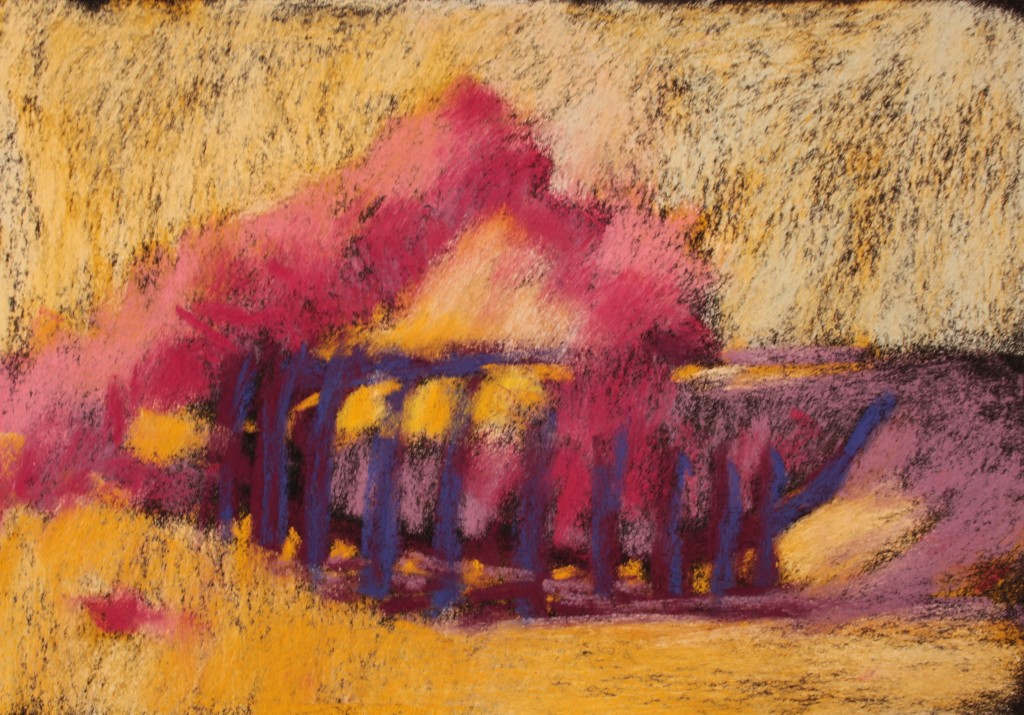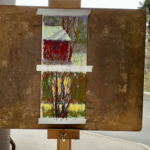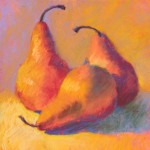Occasionally I get asked the question: Do you ever use soft pastels on black paper? And the answer is: Well no, I don’t. Mind you, when I first started in pastels over 20 years ago, I worked on a dark green mat board. So I have worked with pastels on dark paper, just not black paper. But once I discovered sanded paper, ie Wallis paper which came in the warm mid-value colour known as Belgian mist that I used at first, it was bye-bye dark paper!
When thinking about what I could do a new pastel demo for YouTube on, I recalled the question about pastels on black paper and here you have the result. I’m using pastels from Mount Vision’s workshop set of 50 pastels on Schmincke’s Sansfix pastel card.
Now funnily, it took me some time to choose the colours I would use for the first layer. I say funnily because usually, I work with a much more limited choice of colours ie. smaller pastel starter sets. Having more choice made it more difficult to choose! But it was fun dipping into the jewel box 🙂
Have a look at the video:
And here’s the set-up:

And my thumbnails:

The Mount Vision set from which I chose the pastels:

Let’s look at a few stills showing the progression:





![Pastels on black aper: Gail Sibley, "Untitled [at this point], Mount Vision pastels on Sansfix pastel card, 5 1/2 x 7 3/4 in](https://www.howtopastel.com/wp-content/uploads/2016/04/IMG_9649-2-1024x712.jpeg)
![Pastels on black paper: Gail Sibley, "Untitled [at this point], Mount Vision pastels on Sansfix pastel card, 5 1/2 x 7 3/4 in. In black and white for fun!](https://www.howtopastel.com/wp-content/uploads/2016/04/IMG_9638-1024x713.jpeg)

I love Mount Vision pastels. They are difficult to describe as they are soft and yet have a grittiness that I really like – totally the opposite of ‘buttery’ and yet, like I say, soft. There are some fabulous colours in an extensive value range and they are BIG. Fantastic value. I highly recommend them. Go check the Mount Vision website for a good drool! I love how you can search colours by value.
I had never tried Schmincke’s Sansfix paper before and I liked it. It reminds me of Sennelier’s La Carte Pastel card but I would have to try them side-by-side to make a true comparison review.
So tell me, do you use pastels on black paper? If you do, why do you like it? If you don’t, why not? Please leave a comment – I always love your input!!
Until next time,
~ Gail

![Pastels on black aper: Gail Sibley, "Untitled [at this point], Mount Vision pastels on Sansfix pastel card, 5 1/2 x 7 3/4 in](https://www.howtopastel.com/wp-content/uploads/2016/04/IMG_9649-2.jpeg)



























32 thoughts on “Using Pastels On Black Paper”
I love to use black as an underpainting when I want really strong contrasts in a work. Incredibly vibrant effects can be achieved by allowing the black to peep through colour layers allowing the dynamic contrast to make the pastel shimmering and luminous. Thus is evident in the background at the beginning of your demo piece. It is also beautifully effective in portrait works where by varying the pressure on the pastel it is possible to create very subtle tonal and temperature transitions in the skin. Cheers
Leoni
Leoni, thanks for your voice in this conversation.
I know that black would be perfect for foil for vibrant colours as seen at the start of my pastel. I was thinking perhaps I should have stuck with a bright colour set up as it would have shown off the positive aspects of working on black but I thought the set up I did choose would be a good challenge.
I’m interested that you say that you find black a good surface for portraits. I would have thought it too grey, too ‘dead,’ for that and I’d normally choose a colour, even a dark one, over the black. So thank you for sharing how you make it work! Wow.
I’ve tried black paper twice.The first was a nightmare.I was doing a surprise for my friend of his red Corvette.First of all the red lost some of its brightness,second,it was almost impossible to blend,it just came off the paper.If I remember correctly it was Murano paper.I sprayed it with cheap hair spray like I had in the past,but this time it ruined it,because I used stick pastels as well as pencil.I went over it again to save it.It was fine he loved it.2nd time was a cut crystal glass.Very demanding to do,but also easier because I wasn’t blending two colours,only white and grey.I surprised myself.Its possibly my best piece to date.I like the effect.The stark contrast.I’m looking forward to doing more glass possibly Pewter as well.
Ed thanks for sharing your experiences with black paper. I do think it works well for some people and certainly the more you work with it (as is true for much else), the more you learn to incorporate the darkness of the paper into the piece.
Genius!
Heh heh
Love your video and the result on black paper. Haven’t done any pastels on black paper. Have you done the same hair band and boa on a lighter paper than you would normally use? It would be interesting to see the differences in color selection and value.
Thanks Marie! I have not painted these items before. Good idea to try them again on a lighter paper. Wait and see 🙂
I don’t have a recent example because I haven’t done many pastels in the past few months, but I love working on black paper. Light and bright colors just shine, darks come out rich, it’s just beautiful to me.
I like using broken color on it because the little black dots make all the colors zing. I don’t usually cover it as thoroughly as you did, so it has some hints of pen stippling in areas of broken color. I find white paper flecks distracting, though russet specks in a landscape can help jazz up the greens. On black the little areas of black that show have a great impact. Even mid value colors will seem brighter and more intense. It gives a “stained glass” look and I’ll sometimes also use linear elements to further enhance that.
Robert thanks for adding your high praise of black paper! I know that bright colours do pop on black but I hadn’t thought about the lights and darks.
I think that working as small I was, leaving black speckles would have been too distracting especially in the very light areas. I have to say though, that with more attempts and larger size, I might get the hang of working on black paper. Having said that, I’m not sure I’m tempted to continue. Wait and see. You never know!
I like the way you described working on black paper. I too find white specks distracting but again, I think it depends on where they are showing – certainly the white showing is more distracting under dark areas.
When you mentioned using linear elements to enhance the ‘stained glass’ look, I couldn’t help but think of the work of George Rouault! It would be cool to use black paper that way!
I love it when I open my email and there is a pastel posting from you. I so look forward to it. Thank you and keep up the great work! 🙂
Awww Maureen, you made my day! Thank you!!
Hi Gail,
Thanks so much for this video! I have used black, dark blue, dark purple, etc. papers and find they are great for night scenes, or high contrast paintings, since the colors really pop off the page.
I love your How to Pastel site with all my pastel students. You actually highlighted Maureen Spinale recently, who has been studying with me for about 10 years. We were all thrilled for her! Thank you so much for that!I have been teaching art for 42 years, the last 19 petty much exclusively pastels to adults. Keep up the great work and Iook forward to your next post!
Best, Donna Rossetti-Bailey
Donna, thank you for your comment. I’m intrigued by the use of black paper. I can see how dark colours (as opposed to black) can enhance a piece but loving to hear such ardent admirers and users of black paper. Of course when you mentioned night scenes that totally made sense. When you talk of high contrast, do you mean in value as in very light through to very dark? I can see vibrant colour popping and wonder if you mean that?
How thrilling to see a student improving and then being highlighted. I do like Maureen’s work and have come close in other months to featuring her work so was delighted to finally including one of hers!
Congratulations on your long years of teaching art and so many with pastels. You obviosuly have been very successful at it!
I certainly appreciate your kudos on my website. Makes all the work totally worthwhile 🙂
I’m a Mount Vision fan, tried a few and quickly ordered more. Black paper: tried it, got stuck in the black speckle stage knowing I would need many layers and being somewhat heavy handed, just set it aside. It is still in a stack somewhere waiting for finish. White speckles don’t bother me but the black speckle stage stopped me – curious. Oddly, dark grey dosen’t give me a problem so guess I’ll find that stashed start and give it another try.
I enjoyed your painting on black especially how you worked through the black speckle stage. Love your light hand and whisper layers but question the need for black as a support. I’d like to try the Schmincke paper – maybe grey. Thanks as always.
I’m glad to hear there’s another Mount Vision fan out there! Loved your story around back paper Gailen and will be interested to know if you retrieve it and give it another go! I know what you mean about the use of black paper as a support if one just covers it all up. It’s value lies in leaving some of it visible! Glad you enjoyed the video – happy I decided to upload it after all!
I took a few lessons from someone and had to use black poster board, zero tooth. It was a different and difficult thing to do compared to using a paper with tooth.
Here are a couple of pictures that I did on the black if anyone is interested: Image 1 and image 2
Hi Brenda, thanks for sharing some of your work on black paper. Wow – I can’t imagine working on poster board – difficult indeed!!
Lol Oh no, poster board !! Your post is giving me nitemare flashbacks from back around 1991 when I tried that. Lol
I’ve used black sanded multimedia board several times and loved it.
Hah hah Darren! Still, I see that you are using black as a surface to work on!
I’ve used black sanded paper for years , a lot in river and stream paintings , and I leave a fair amount of black showing in the water.
Thanks Rae. I think the trick is to figure out how to leave the paper showing and make use of it. In my set up, I couldn’t find that possibility. I think done in vibrant colours, black showing would enhance rather than detract.
Hi Gail,
I enjoyed watching your video. I saw Kurt Weiser do a double demo five or six years ago. He did two tree landscapes, one on black paper and the other on light. They were both beautiful, but the trees on the black surface really popped! I had to try it later, and I loved it! I’ve done more than a few now, many on the back of black Canson and some more on Anthracite Pastelmat, which is also fairly dark. I can still use Terry Ludwig’s Intense Darks on the black to enhance and vary the darks, making the light and mid-tones really “sing” with the little pops of black.
I think you might like a black surface if you leave some of it untouched, and used the black paper as dark or shadow areas. Anyway, I hope you’ll give it another try sometime because the effects can be very dramatic and satisfying!
I love reading your blog and watching your videos! Thanks again,
Eileen
Eileen, thanks for sharing your experience with Kurt Weiser demo. And thanks too for describing your process and the materials you use. I am sure you are right about leaving the black paper. I will try again soon!
So glad you are enjoying my blog and videos 😀
I’ve always fancied trying black paper.When I saw my friend’s,(Ralph), brother Joe’s photo he took of Ralph’s Corvette,I just had to draw it and send it to Ralph as a surprise present.Joe is a professional.He took the photo in Ralph’s garage.Turned off the lights,then using tape,he blocked out all the light coming in.Camera on a tripod.Shutter held open.He went all around Ralph’s Corvette with an inspection light.Wow! what a photo.To make a long story short.I tried many papers.I use Faber Castell pastel pencils and I just couldn’t blend the chalk.It didn’t stick to the paper like it normally does.Someone suggested I try watercolour pencils.So,I ordered aprox 12 different shades of red,hoping that I would get the right colour.I sprayed it with cheap hair spray like always,but this time it got ruined.So I tried to salvage it by going over it,and found the chalk stuck better now.Framed it,sent it and he loved it.It was Murano Midnight.Haven’t done any since.
Wow Edward, that’s quite the story! So did you use black paper??
I adore black paper. Especially Sennelier’s La Carte, followed by Richardson’s. I used them almost exclusively for about 3 years. They really make colors pop – and as a colorist – that’s what I value so greatly. It also means I can work with more darks because the surface is more forgiving.
I switched over from black to UArt because I like the texture of the paper more and I began to experiment with underpainting. I find though, that I miss my black background so much, that I’ve started going back and experimenting with a solid black underpainting on UArt 280 using a wash of water-soluble oils or gouache. I’ll let you know how the experiment turns out. 🙂
And thank you for letting me join your Facebook Group and this blog. I’ve enjoyed your paintings for years and I’m enjoying everyone’s contributions. There’s nothing like learning to keep the juices flowing. Thanks Gail!
Hi Mary, thanks for vocalizing your love of black paper. I am hoping that UArt will bring out both a mid-value paper and a black. Perhaps drop them a suggestion. Still, it sounds like you’ve found a work-around.Yes, let us know how your experiments work out. It may work out that you like these the best!
Thank you for the compliment on my work 😀 And you are so right about learning!
Daisy Craddock, an artist I truly admire, uses black paper with oil pastels. That really intrigues me, and I plan on pursuing more black underpainting, or papers. As I’m sure you know by now, Uart has come out with a black sanded paper which is very intriguing. I’m a big Uart fan. I think the black can make the soft pastels, which can be too lightish and bland, really pop.
Thanks Amy! And yes, I know about UART’s black version. Pastel Premier also have a back sanded paper too. One of these days I will try using black again 🙂 Look forward to seeing more of your work! Thank you for letting us know about Craddock’s work too.
Another trick I’ve done is to paint my sanded board black in the areas I want dark with India ink.
Cool. I am assuming you mean you are painting a light-coloured board black. You could also do the same thing on black paper as some black sanded papers are not as densely black as they could be. Thanks for the tip!